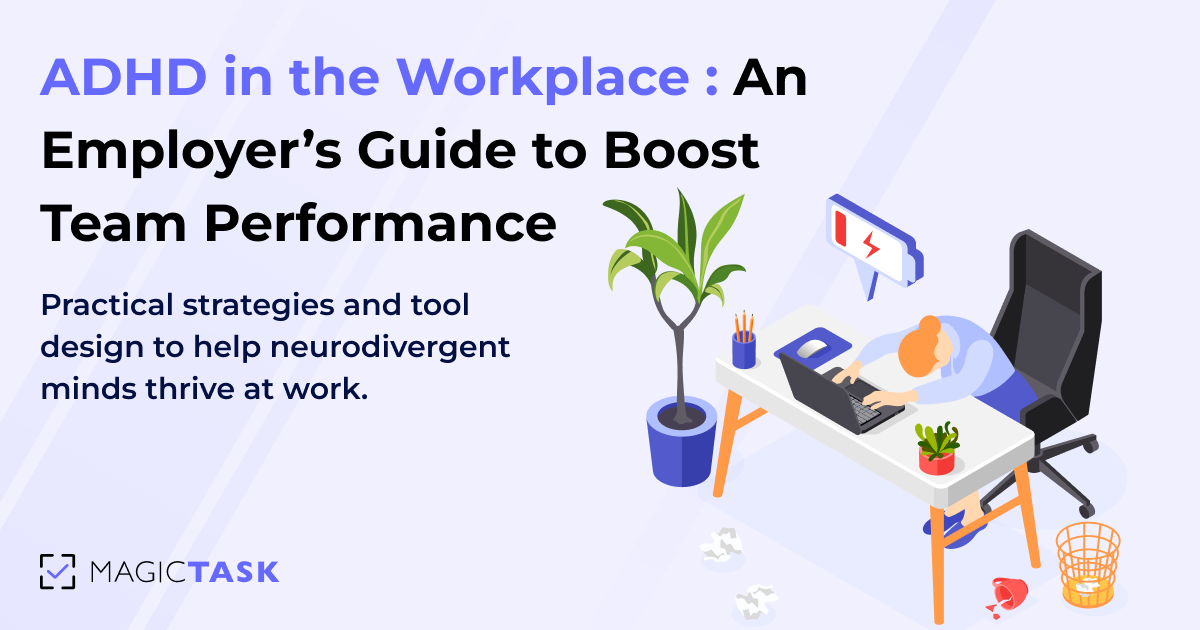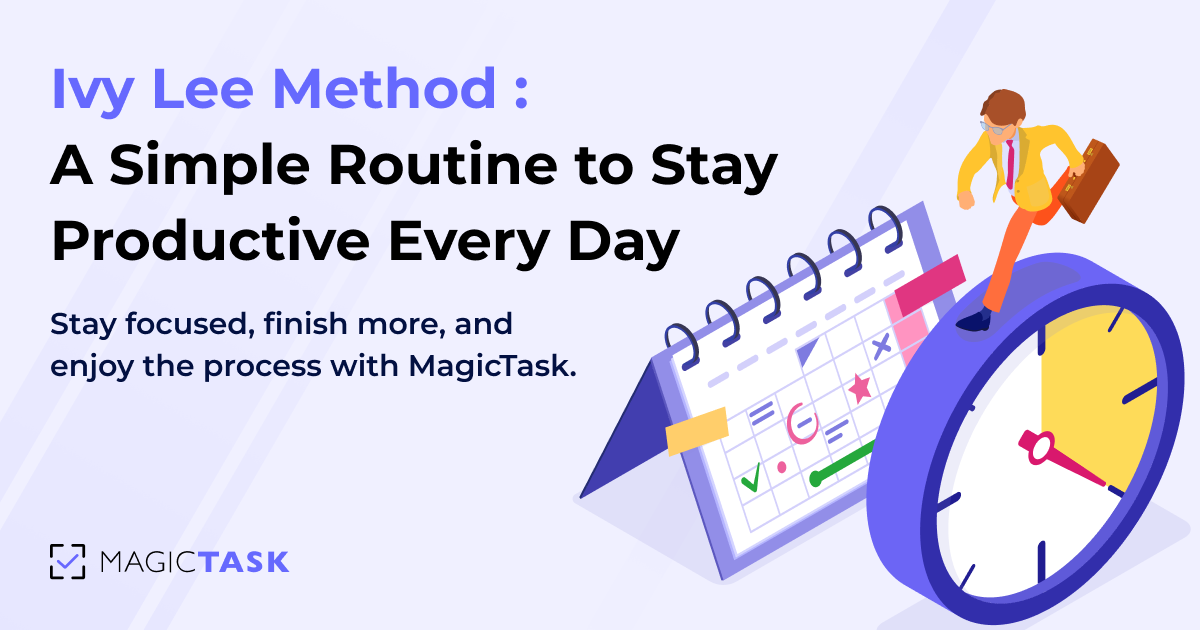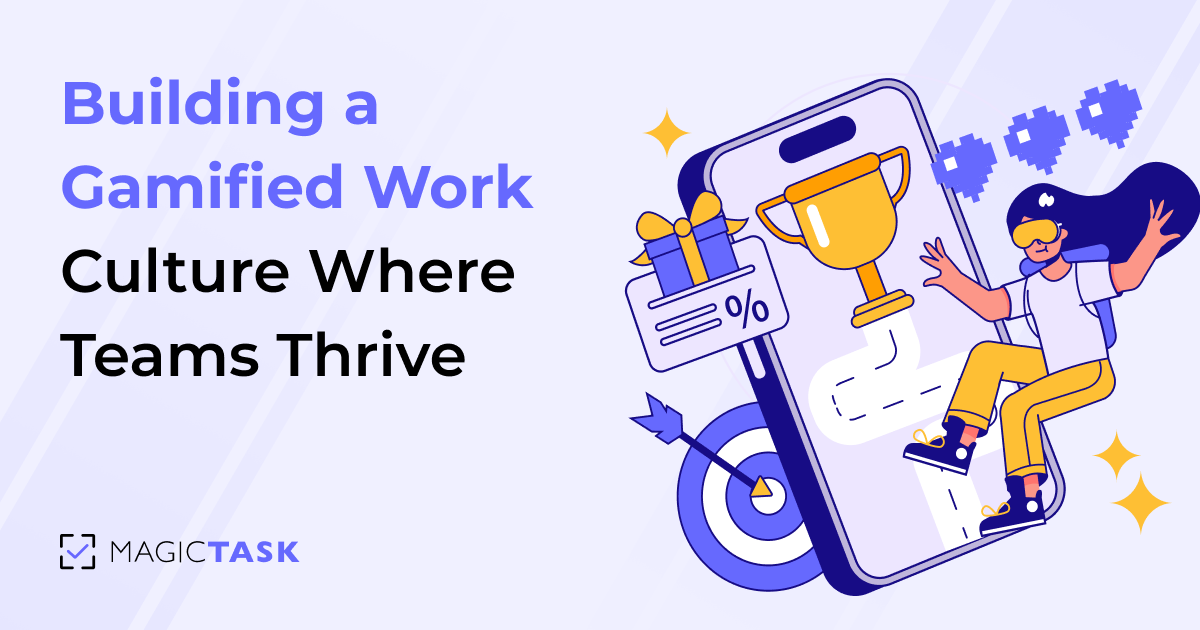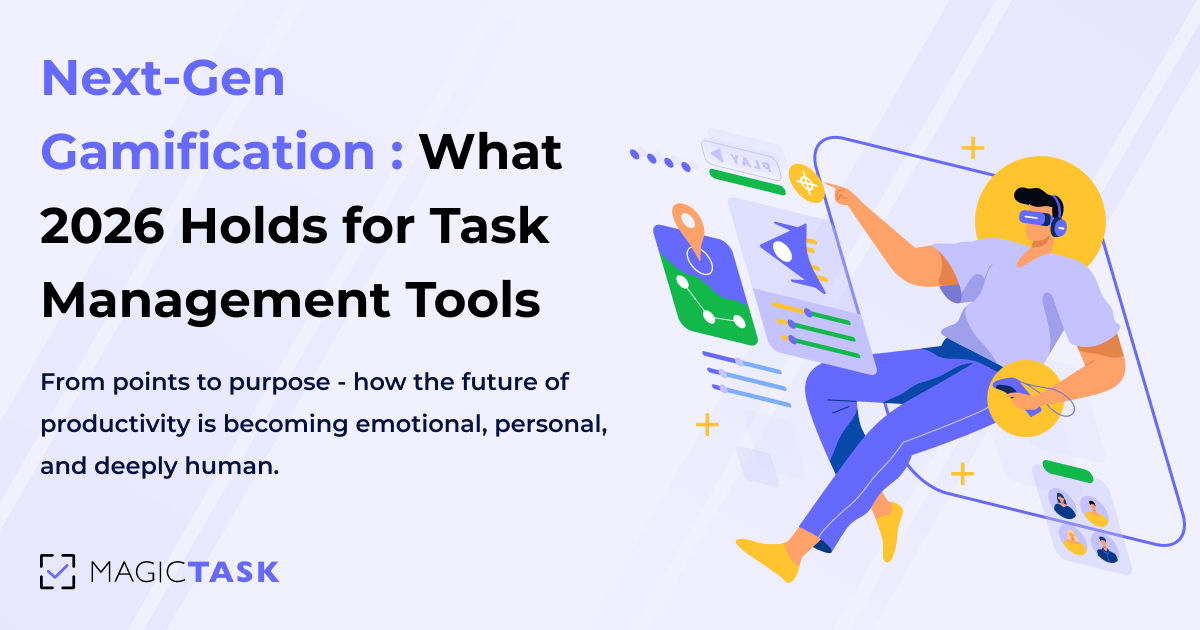Can’t Focus at Work? Gamification Can Help Beat Distractions
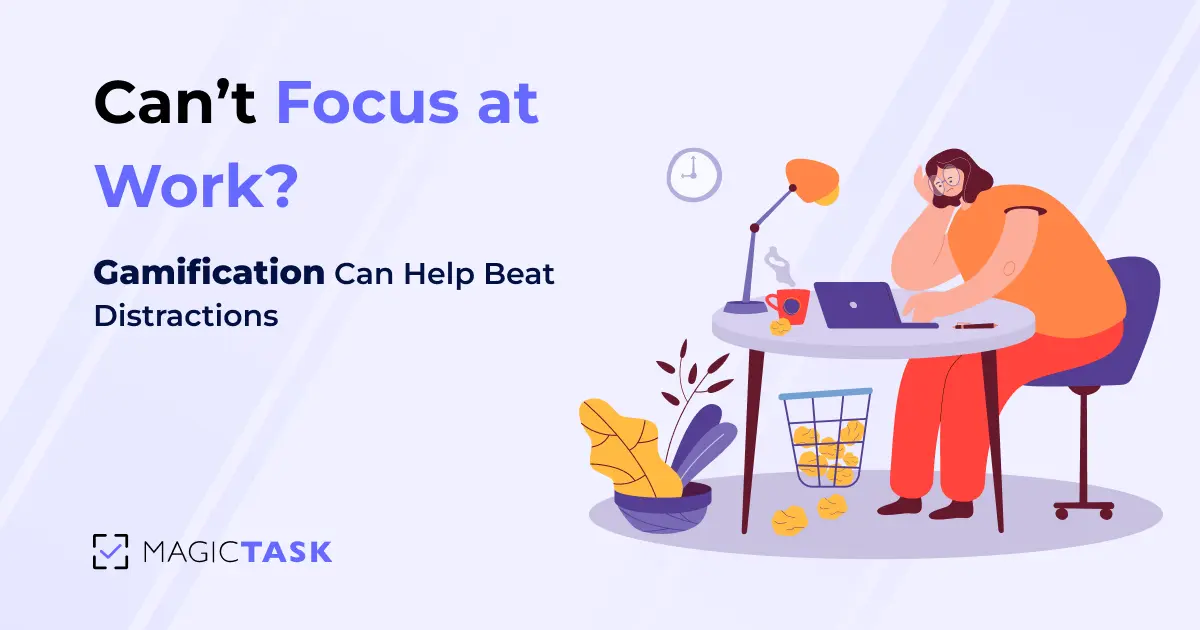
Distraction is a daily battle, especially when work tools feel more like noise than support.
Between Slack pings, email threads, and switching between five apps just to get one task done, it’s no surprise that focus feels fractured.
Most people try to fight through it with willpower, timers, or strict routines. But those only go so far when motivation dips.
The real problem is that most productivity systems aren’t built to keep your attention. They list what needs doing but offer no real reason to stay engaged.
That’s where gamification comes in.
This blog explores how gamification reshapes the way you approach focus and shows how MagicTask uses it to make deep work feel less like effort and more like progress.
Why It’s So Hard to Stay Focused at Work Today
The frustration isn’t that you don’t care about your work; it’s that staying focused feels like a constant uphill battle, even on tasks you want to finish.
And it’s not just you.
Modern work environments are built for speed, not clarity. You’re expected to juggle emails, chat notifications, meetings, task boards, and long-form work, all at once.
That constant switching breaks concentration and drains mental energy faster than you can refill it.
In the 1920s, psychologist Bluma Zeigarnik discovered something many of us experience daily: incomplete tasks linger in the mind more than completed ones. This is now known as the Zeigarnik Effect.
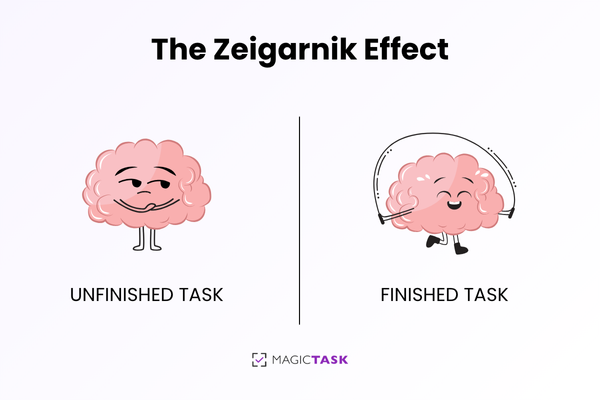
Your brain holds onto unfinished work like an open loop, constantly nudging you to complete it. That nagging feeling when you leave a task half-done? It’s your cognitive system trying to resolve tension.
Now, imagine juggling 10 open loops at once. No wonder focus slips.
Even when you sit down with the best intentions, your brain is pulled in a dozen directions:
- Text notifications pop up mid-sentence
- You open one browser tab and end up with 12
- You keep shifting between tools, trying to find where the “real” work lives
This scattered setup breeds overthinking. Without clear next steps or visual momentum, it’s easier to procrastinate than to push through.
Traditional task systems don’t help much either; they just display what’s pending, not what’s moving forward.
At the end of it all, you’re left managing tasks manually and forcing focus that never really sticks.
How Gamification Rewires Focus and Attention
Trying to fight distraction with willpower alone is like trying to hold your breath all day. It works briefly, then collapses.
The better strategy is to create an environment that captures your attention, rather than letting it drift.
1. Focus Becomes a Game Loop
Focus isn’t something you force; it’s something that emerges when effort is met with visible progress.
In behavioral psychology, this is called a feedback loop:
- Cue
- Action
- Reward
It’s the foundation behind why we stay glued to games, fitness trackers, and habit apps.
Each action leads to a small win. Each win signals progress. That sense of forward motion triggers dopamine, not just from finishing, but from anticipating the reward that follows.
This expectation creates momentum. Focus stops feeling like a chore and starts feeling like progress.
As Nir Eyal, author of Hooked, explains:
“The more effort people invest in a product, the more they value it.”
That effort, when acknowledged and rewarded, becomes intrinsically motivating.
You’re no longer just crossing off tasks; you’re advancing. And when the brain sees evidence of advancement, attention sharpens naturally.
2. Completion Triggers Dopamine
Every time you complete a task, your brain gets a chemical boost.
Dopamine, the neurotransmitter associated with pleasure and reward, is released not just when you achieve something big, but when you complete even the smallest of actions, like ticking a checkbox or submitting a form.
This isn’t accidental.
Our brains are wired to seek patterns of reward. The more frequently we experience that sense of completion, the more likely we are to repeat the behavior.
That’s why consistent progress that is visible and achievable matters more than occasional grand achievements.
Over time, this creates a self-reinforcing loop:
- Task completed → dopamine spike → positive emotion
- Positive emotion → motivation to repeat the behavior
- Repeated behavior → habit formed
But it only works when the feedback is immediate. If your tools delay or hide progress, your brain doesn’t connect the effort with the outcome. The motivation fades. When progress is visible and immediate, you train your attention to stay engaged. Momentum builds. Focus deepens.
3. Flow Replaces Friction
Focus feels challenging when every task requires extra thought, such as deciding what to do first, how much time to allocate, and where to begin.
These micro-decisions create friction that adds up fast, especially in environments filled with distractions.
Flow is a state where you're fully immersed in the task at hand. It’s when the challenge level matches your skill, and distractions fade into the background. You’re not forcing attention; it just happens.
Gamification reduces friction by removing decision fatigue and injecting momentum.
When tasks are clearly defined, progress is visible, and rewards are immediate, your brain shifts from hesitation to action. Completing one small task pulls you naturally into the next.
Instead of wrestling with a to-do list, you enter a rhythm of cue, action, reward.
That’s the beginning of flow.
What breaks the flow?
- Unclear priorities
- Decision fatigue
- Too many simultaneous tasks
- Delayed feedback or no reward
What creates flow?
- Defined task size and scope
- Fast feedback loops
- Small wins that lead into the next task
- A rewarding system that nudges progress
How to Start Using Gamification to Stay Focused (with MagicTask)
You don’t need to overhaul your workflow to stay focused. You just need a system that rewards momentum and reduces friction.
MagicTask integrates gamification into the most minor details of your day, helping you stay focused without relying on willpower or external motivation.
Here’s how to put it to work:
1. Assign Task Sizes to Reduce Decision Fatigue
When you start the day with a long list of vague tasks, it’s easy to freeze or pick the easiest one just to feel productive. MagicTask solves this by letting you label every task with a size—Small (S), Medium (M), Large (L), or Extra Large (XL).
These sizes act as built-in difficulty levels that help you plan your day without overthinking.
Instead of guessing what to do next, you look at the task size, check your energy or time window, and start. It’s instant clarity with zero mental load.
Here’s how the sizing works:
| Task Size | Time Needed | Example |
|---|---|---|
| S (Small) | 5–10 minutes | Reply to an email |
| M (Medium) | 30 minutes | Write a short status update |
| L (Large) | 1–2 hours | Draft a blog post |
| XL (Extra Large) | Half a day or a full day | Build a product roadmap |
Why it works:
- Removes the friction of choosing what to start
- Matches tasks to your available energy or time
- Keeps big projects from feeling overwhelming
How Task Sizing Reduces Mental Overload
Your brain has a limited amount of mental bandwidth at any given moment.
Cognitive Load Theory, developed by educational psychologist John Sweller, explains that when too much information or complexity is thrown at the brain at once, performance suffers.
You’re more likely to procrastinate, make errors, or abandon tasks entirely.
That’s exactly what happens with long, unstructured to-do lists.
You stare at a wall of tasks, some tiny, some enormous, and your brain freezes trying to figure out where to start. This mental overwhelm is not a motivation problem. It’s a load problem.
Task sizing is a practical antidote. Instead of tackling vague or unevenly scoped tasks, you break them down into smaller, more manageable tasks.
This structure reduces ambiguity and gives your brain fewer decisions to make. You can scan your task list and start immediately, without falling into analysis paralysis.
2. Earn Points with Every Completed Task
Every time you complete a task in MagicTask, you earn points. It’s simple, but powerful.
These points serve as instant feedback —a small “win” that tells your brain, “Well done, keep going.”
This isn’t just for fun. It’s based on behavioral reinforcement. When your brain sees progress and reward, it releases dopamine, which makes it more likely you’ll return to the task.
Over time, you begin to associate work with accomplishment, not just effort.
Here’s what this looks like in practice:
- You check off a Medium task → you get points based on effort
- Your total score increases visibly on your dashboard
- Your progress nudges you closer to a theme level-up or visual reward
- Each small win builds momentum for the next task
You’re not waiting for an end-of-week milestone to feel successful. The system rewards steady daily progress. It’s like turning productivity into a game you actually want to keep playing.
3. Level Up Themes for Long-Term Motivation
MagicTask takes the satisfaction of progress a step further with Theme Leveling. As you complete tasks and earn points, you unlock visual and sound-based rewards tied to your chosen theme, arcade, gaming, glitch, and more.
Each level unlocks subtle animations, mood shifts, or sound cues that make your workspace feel alive. This transforms routine work into a personalized experience, one that visually reflects your growth.
Why it matters:
- Visual evolution keeps the experience fresh and engaging.
- Sound effects and motion act as feedback loops that reinforce progress.
- It creates a sense of “place” and identity within your productivity system.
Instead of your task app feeling flat or sterile, it starts to feel like a space that evolves with you, rewarding your consistency without demanding more effort. You’re not just managing tasks, you’re leveling up your workflow.
4. Use Folders and Projects Like Quests
In MagicTask, folders and projects are mental zones that help you focus deeply. Each folder becomes its own “questline,” giving your work structure, narrative, and intention.
Just like a game separates missions into levels or stages, using folders helps you:
- Break down complex work into manageable zones
- Keep context intact for each area of focus (e.g., “Client Work,” “Personal Growth,” “Team Planning”)
- Shift gears without losing momentum — you're switching quests, not aimlessly tabbing
This mental segmentation makes multitasking less chaotic. You’re progressing through clearly defined zones of attention. Over time, each folder becomes a visual and mental anchor that makes it easier to lock in and execute.
Why Gamification Works When Other Focus Hacks Don’t
Most productivity systems assume you just need more structure. They offer timers, routines, or accountability hacks to help you stay on task.
The problem?
These all rely on willpower. If your energy dips or your day gets chaotic, they tend to break down.
Gamification, on the other hand, taps into internal drive. It rewards action, not just discipline. You’re not pushing yourself to stay on track. The system pulls you in through visible progress, micro-rewards, and flow.
This is especially true with tools like MagicTask, where a clean UX and subtle game mechanics make work feel engaging, rather than a grind.
To illustrate how this differs from conventional methods like Pomodoro, here’s a quick comparison:
| Approach | What It Relies On | How It Helps | Where It Struggles |
|---|---|---|---|
| Pomodoro Timer | External discipline | Creates time-boxed focus sessions | Can feel rigid or interruptive |
| Gamification Loop | Internal motivation | Makes progress feel satisfying | Needs a design that doesn’t distract |
| Combined Approach | Structure + engagement | Balances consistency and flow | Works best with simple systems |
Used effectively, the Pomodoro technique can absolutely help, especially when paired with a gamified system. The timer provides boundaries, while the rewards keep you emotionally invested.
Conclusion
Focus is a system. And in today’s distraction-heavy world, systems win where willpower fails.
Gamification isn’t a gimmick. It’s a behavioral framework grounded in psychology, designed to make progress feel satisfying.
When done right, it doesn’t just help you stay on task; it makes you want to come back and keep going.
MagicTask brings this system to life without clutter or complexity. Task sizes, points, and visual rewards are all designed to help you lock in and follow through.
Instead of forcing discipline, try a system built for how your brain actually works. Try MagicTask and make focus feel effortless.
